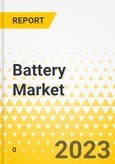This report comes with 10% free customization, enabling you to add data that meets your specific business needs.
The rapid growth of the battery market for IoT can be attributed to several key factors. Firstly, the widespread deployment of IoT devices across various industries, ranging from smart homes to industrial automation, is increasing the demand for dependable and long-lasting power sources. Furthermore, advancements in battery technology, such as the creation of high-energy-density and rechargeable batteries, play a crucial role in extending device lifespan and enhancing overall performance. As IoT applications continue to diversify, encompassing areas like healthcare and agriculture, there is a growing demand for specialized batteries tailored to meet unique requirements, further contributing to the expansion of the market. In summary, the significant increase in IoT adoption and ongoing innovation in battery technology are pivotal drivers behind the robust growth of the battery market for IoT.
Despite its promising growth prospects, the battery market for IoT encounters challenges. Technical hurdles arise from the requirement for compact, lightweight batteries with high energy density. Additionally, the demand for sustainable and environmentally friendly power sources places pressure on manufacturers to devise eco-conscious solutions. Nevertheless, the market is set for expansion in the forecast period due to the increasing adoption of IoT devices. Progress in battery technologies, such as enhanced energy efficiency and longer life cycles, plays a role in this growth.
The rising integration of IoT across various sectors, spanning from smart cities to industrial automation, intensifies the need for dependable and efficient power solutions, propelling market growth. In conclusion, the battery market for IoT not only navigates challenges but also flourishes, driven by technological advancements and the growing need for dependable, efficient power sources across a range of IoT applications.
Market Segmentation:
Segmentation by End User
- Consumer Electronics
- BFSI
- Industrial
- Agriculture
- Aerospace and Defense
- Healthcare
- Others
Segmentation by Type
- Chemical Batteries
- Printed Batteries
- Thin Film Batteries
- Solid State Chip Batteries
Segmentation by Rechargeability
- Primary Batteries
- Secondary Batteries
Segmentation by Region
- North America
- Europe
- Asia-Pacific
- Rest-of-the-World
Key Market Players and Competition Synopsis
Some of the prominent companies in this market are:
- Panasonic Corporation
- Duracell Inc
- LG Chem Ltd
- STMicroelectronics N.V
- Ultralife Corporation
- Samsung SDI Co
- Cymbet Corporation
- Enfucell OY
- Rocket Electric Co. Ltd
- SAFT Groupe SA
- Blue Spark Technologies
- Imprint Energy
- Jenax Inc
- Power Paper Ltd.
- Front Edge Technology Inc
Key Questions Answered in this Report:
- What are the main factors driving the demand for battery market for IoT?
- What are the major patents filed by the companies active in the global battery market for IoT?
- What are the strategies adopted by the key companies to gain a competitive edge in battery market for IoT?
- What is the futuristic outlook for the battery market for IoT in terms of growth potential?
- Which application, and product segment is expected to lead the market over the forecast period (2023-2033)?
- Which region and country is expected to lead the battery market for IoT during the forecast period?
- How do battery solutions align with evolving regulations and standards in the IoT industry?
This product will be updated with the latest data at the time of order. Consequently, dispatch time for this product will be 7-10 business days.
Table of Contents
Companies Mentioned
- Panasonic Corporation
- Duracell Inc
- LG Chem Ltd
- STMicroelectronics N.V
- Ultralife Corporation
- Samsung SDI Co
- Cymbet Corporation
- Enfucell OY
- Rocket Electric Co. Ltd
- SAFT Groupe SA
- Blue Spark Technologies
- Imprint Energy
- Jenax Inc
- Power Paper Ltd.
- Front Edge Technology Inc








